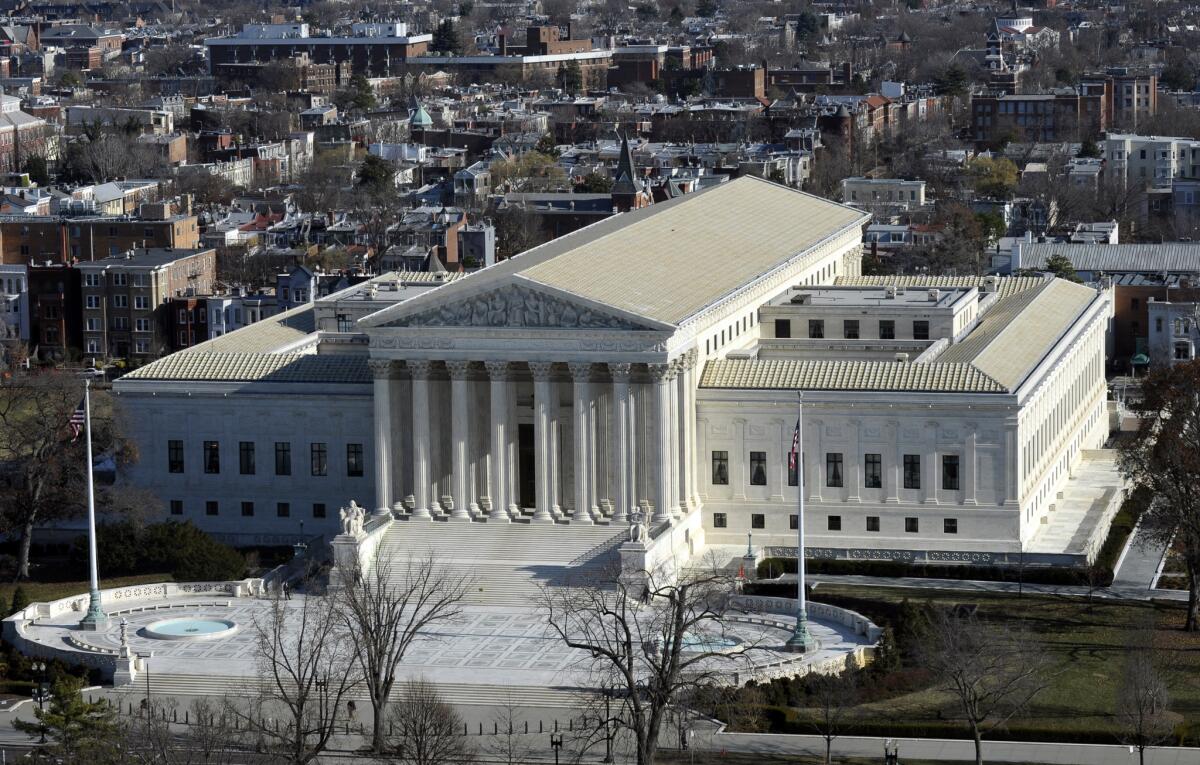Supreme Court may again fast-track a legal dispute over Trump’s immigration plans

- Share via
WASHINGTON — The Supreme Court is weighing a fast-track appeal from the Trump administration that seeks to close the door to nearly all migrants who seek asylum at the southern border. And once again, the justices are being asked to decide a far-reaching legal question on a rushed basis, without the usual oral arguments or months of deliberation.
Since 1980, U.S. law has promised those who flee persecution and violence in their home country a right to at least apply for asylum here. But on July 16, the Trump administration announced a new rule that would declare “ineligible” those who traveled through Mexico and did not seek asylum there.
The emergency appeal filed late last month on behalf of Atty. Gen. William Barr asks the justices to set aside lower court orders blocking the rule and allow it to be enforced immediately. A decision could come within a week.
If the court’s conservatives agree and grant Barr’s appeal, it would be the latest example of how the Trump administration is making major changes in the execution of laws while bypassing Congress and avoiding months or even years of fighting in lower federal courts.
Normally, the high court agrees to review and decide a legal question only after a case has been decided by a federal district judge and a federal appeals court.
But increasingly in the Trump era, the justices are deciding major issues by acting on emergency appeals filed after one of the administration’s new rules is blocked in a lower court.
In July, for example, Trump won the right to divert billions of dollars that Congress appropriated for the military to begin building the U.S. Mexico border wall he promised during his 2016 campaign. Congress had refused to pay for the wall, so Trump declared he had the emergency authority to transfer money from other departments and agencies.
A federal judge in Oakland and the 9th Circuit Court blocked the transfer as illegal. But acting on an emergency appeal from Solicitor Gen. Noel Francisco, the high court voted 5-4 to lift the lower court decisions in a one-paragraph order in Trump vs. Sierra Club. The justices did not hear arguments in the case and did not issue a majority opinion or a dissent.
University of Texas law professor Stephen Vladeck says Francisco has been “unusually aggressive in seeking emergency or extraordinary relief” from the justices, and he has been winning. “I think there’s no question there has been a shift in how at least a majority of the justices approach such applications,” he said.
In the past, it was rare for the government’s top lawyers to ask the high court to intervene and rule in a pending case. Under the court’s rules, lawyers filing such appeals have to argue that their clients face a serious or irreparable harm if the high court fails to act. And the justices have often said they are reluctant to decide an important legal question on a rushed basis.
Irv Gornstein, director of the Supreme Court Institute at Georgetown’s law school, cited several reasons for the change.
“We have a president who is pursuing many more controversial and divisive policies than his predecessors. We have lower courts that are skeptical of both the president and his policies. We have a solicitor general’s office that is optimistic that taking issues to the high court will bear fruit. And we have a Supreme Court that is ready to act at an early stage when it thinks the lower courts have gone off the rails,” he said.
The asylum law is now at the center of Trump’s immigration battle. The law says, “Any alien who is physically present in the United States or who arrives in the United States, whether or not at a designated port of arrival ... may apply for asylum.”
Trump and his administration have chafed at this open-door policy. Officials say it permits tens of thousands of migrants to get a foothold in this country while their asylum claims work their way slowly through the immigration courts. They say only a small percentage will finally win their claims.
The Justice Department told the court it had more than 436,000 asylum claims pending.
But rather than persuade Congress to change the law, Trump has sought to weaken it through new regulations.
On July 16, the administration announced what it called an “interim final rule” that would deem migrants “ineligible” for asylum if they had traveled across Mexico without seeking asylum there.
A federal judge in San Francisco and the 9th Circuit blocked the new rule from taking effect, ruling that it conflicted with the promise of the asylum law.
But Francisco filed an appeal on Aug. 26 that faulted the lower court judges for “second-guessing” the administration’s policy and urged the high court to allow the new rule to go into effect. It will “screen out asylum seekers who declined to request protection at the first opportunity” in Mexico, and it will “alleviate a crushing burden on the U.S. asylum system,” he said in Barr vs. East Bay Sanctuary Covenant.
Francisco pointed to provisions in the asylum law that said immigrants could be sent to a “safe third country” for protection. He also noted the attorney general was authorized to set “other conditions or limitations” on asylum.
Lawyers for the American Civil Liberties Union said the court “should not permit such a tectonic change to the U.S. asylum law.” If put into effect, the new rule “would eliminate virtually all asylum at the southern border,” they said in a response filed Wednesday. “The ban is a blatant end-run around the scheme Congress created” and rests on an “expansive view of executive authority to rewrite the statute.”
The court has no deadline or timetable for acting on the appeal. But usually, the justices take some action within a week or two after receiving briefs from both sides.
More to Read
Get the L.A. Times Politics newsletter
Deeply reported insights into legislation, politics and policy from Sacramento, Washington and beyond. In your inbox three times per week.
You may occasionally receive promotional content from the Los Angeles Times.











